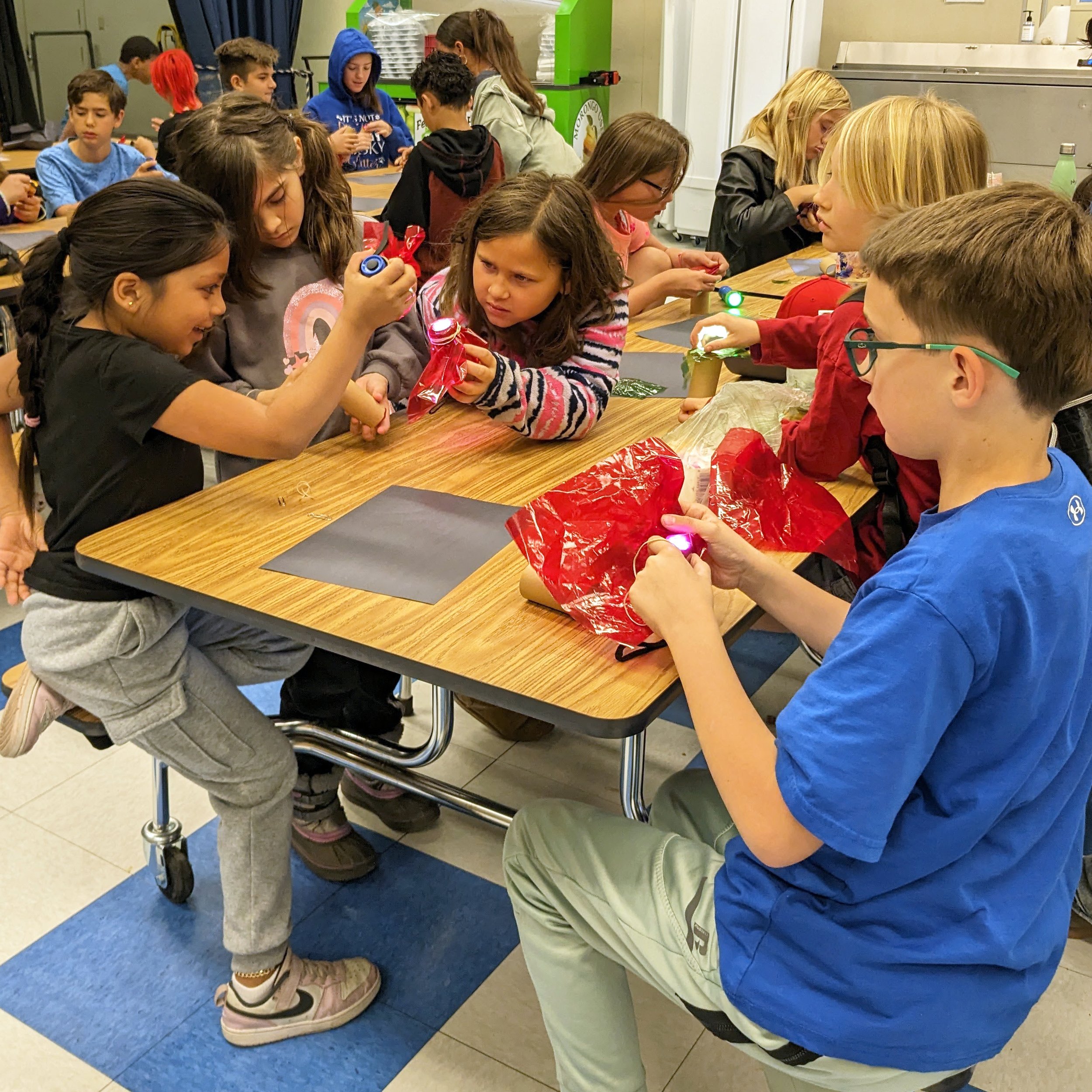Dark skies and fault lines: Interactive education in the Mojave Desert
Young stewards construct flashlights to help them understand how to mitigate light pollution. Photo: Jessica Graybill
The multipurpose room at Yucca Valley Elementary School is abuzz with excited students sharing their designs and discoveries with friends. Each child is constructing a night sky-friendly flashlight using red cellophane, construction paper, and cardboard tubes as part of a Desert Discovery Field Studies (DDFS) lesson exploring the importance of dark night skies and reducing light pollution.
One 3rd grader with a penchant for bats returns to the supplies tub numerous times determined to create the best possible flashlight to protect his favorite nocturnal pollinators from the effects of light pollution. At the end of the lesson, some students volunteer to share their creations with the rest of the class, explaining how their design would protect the night sky. “It was fun and cool to learn about light pollution and how to raise awareness about it,” enthuses one 5th grader.
Throughout eons of human history, the night sky has inspired curiosity, aroused scientific discovery, and facilitated navigation for cultures around the world. This once-reliable phenomenon has been significantly undermined by human-made light pollution. In addition to preventing us from experiencing the wonder of the cosmos as our ancestors once did, light pollution is detrimental to both humans and wildlife alike. It disrupts our circadian rhythms and can negatively impact animal behavior like migration and hunting for food.
Experiential learning is central to the Mojave Desert Land Trust’s DDFS program. With screen time increasing and digital media constantly vying for our attention, providing opportunities for real-world, hands-on education is crucial. When students investigate and share their discoveries with others, they learn faster, understand better, and retain information for longer.
The immersive DDFS program helps students from underserved communities become inspired advocates for their desert home by providing creative, STEM-based activities that engage them with the natural world. Learning labs are designed to complement all subject areas and grades, adhering to Next Generation Science Standards, the California Education and the Environment Initiative, and environmental best practices to teach students about desert ecology, climate change, and ecosystem management in developmentally appropriate ways.
In this particular Saturday Academy, MDLT Education Program Manager Mary Cook-Rhyne (also known as “Miss Mary”) guides students through a range of activities. Next up: how different minerals came together under different processes to form the local geology.
After an overview of local fault lines and learning about igneous, metamorphic, and sedimentary rocks, students develop a deeper understanding of the rock cycle by using different colored doughs to model each type of rock formation. Photo: Jessica Graybill
“Geo means earth and ology means the study of something – so geology is the study of earth,” Miss Mary begins.
“That makes me wonder!” a student calls out.
“What does it make you wonder?”
“If geology is the study of earth, is that related to geometry?”
“Yes! They both have the same root word–geo–and ‘metry’ means to measure.”
“The measure of earth…”
Discovering the common root of both physical and mathematical studies is only the tip of the iceberg. Kindergartners are eager to get to the dough and help pass small tubs of it out to the group. Everyone is excited by the tactile activity of illustrating varied geologic processes with the different colors and observing how they interacted under different types of pressure. The youngest students enjoy seeing how the colored dough makes new colors when mixed completely.
Students learn about the mineral makeup of local geology by using magnets to find iron deposits in the sand. Photo: Jessica Graybill
After recreating seismic activity in the palms of their hands, students take to the playground to look for iron in the sand using hand magnets. Some enjoy finding areas with large deposits of iron and sharing this knowledge with each other, while others get into some friendly competition to gather the most iron in their provided condiment cup. One student picks up an otherwise plain-looking pebble with his magnet and wonders aloud why the magnet picked it up along with the smaller, darker flakes of iron. His face lights up — “There must be a lot of iron in this rock!” he exclaims. A kindergartner realizes she can make the iron in her condiment cup ‘dance’ by moving the magnet over the outside of the cup.
At the end of the day, one of the kindergarteners is asked what her favorite activity was. Her response is an enthusiastic “Everything!” as she follows her parent out the door.
This Desert Discovery Field Studies Young Steward experiential lab was funded by the Outdoor Equity Grants Program, created through AB 209 and administered by California State Parks, Office of Grants and Local Services.




